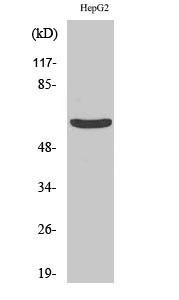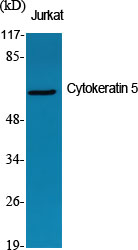

| WB | 咨询技术 | Human,Mouse,Rat |
| IF | 咨询技术 | Human,Mouse,Rat |
| IHC | 1/100-1/300 | Human,Mouse,Rat |
| ICC | 1/200-1/1000 | Human,Mouse,Rat |
| FCM | 咨询技术 | Human,Mouse,Rat |
| Elisa | 1/10000 | Human,Mouse,Rat |
| Aliases | KRT5; Keratin; type II cytoskeletal 5; 58 kDa cytokeratin; Cytokeratin-5; CK-5; Keratin-5; K5; Type-II keratin Kb5 |
| Entrez GeneID | 3852; |
| WB Predicted band size | 62kDa |
| Host/Isotype | Rabbit IgG |
| Antibody Type | Primary antibody |
| Storage | Store at 4°C short term. Aliquot and store at -20°C long term. Avoid freeze/thaw cycles. |
| Species Reactivity | Human,Mouse,Rat |
| Immunogen | Synthesized peptide derived from the C-terminal region of human Cytokeratin 5. |
| Formulation | Purified antibody in PBS with 0.05% sodium azide,0.5%BSA and 50% glycerol. |
+ +
以下是关于 **Cytokeratin 5(CK5)抗体** 的3篇参考文献,涵盖其在不同研究中的应用和意义:
---
1. **文献名称**:*Molecular portraits of human breast tumours*
**作者**:Perou CM, et al.
**摘要**:本文通过基因表达谱分析将乳腺癌分为不同亚型,提出基底样乳腺癌的特征性标志物(如CK5),并利用CK5抗体验证了这类肿瘤的基底上皮细胞起源。
2. **文献名称**:*Cytokeratin 5/6 in epithelial neoplasia: a survey of 435 cases*
**作者**:Chu PG, Weiss LM.
**摘要**:研究通过免疫组化分析435例上皮肿瘤,证实CK5/6抗体在鳞状细胞癌、基底样乳腺癌等肿瘤中的高特异性表达,支持其作为鉴别诊断工具的价值。
3. **文献名称**:*Prostatic basal cells: a proposed role in epithelial homeostasis and cancer*
**作者**:Hudson DL, et al.
**摘要**:探讨前列腺基底细胞中CK5抗体的标记作用,提出CK5阳性细胞可能具有干细胞特性,并在前列腺癌发生中起关键调控作用。
4. **文献名称**:*Cytokeratin expression patterns in normal and malignant urothelium: a review*
**作者**:Moll R, et al.
**摘要**:综述CK5抗体在正常与恶性尿路上皮中的表达差异,强调其在膀胱癌分型及预后评估中的潜在应用。
---
以上文献反映了CK5抗体在肿瘤分型、干细胞研究及临床诊断中的关键作用。
Cytokeratin 5 (CK5) is a type I intermediate filament protein belonging to the cytokeratin family, which forms structural networks in epithelial cells. It pairs with cytokeratin 14 (CK14) to create stable polymers, providing mechanical resilience to tissues. CK5 is predominantly expressed in basal epithelial cells of stratified and complex epithelia, including the skin, mammary glands, prostate, and respiratory tract. Its expression is closely associated with progenitor or stem cell populations in these tissues, making it a key marker for identifying basal/myoepithelial cells in normal and pathological contexts.
In diagnostic pathology, CK5 antibodies are widely used to differentiate tumor subtypes. For example, CK5 positivity helps distinguish basal-like breast cancers (aggressive, triple-negative subtypes) from luminal subtypes, guiding prognosis and therapeutic decisions. Similarly, CK5 expression is observed in squamous cell carcinomas, basal cell carcinomas, and certain mesotheliomas. Its absence in adenocarcinomas aids in differential diagnosis. Beyond oncology, CK5 antibodies are employed in research to study epithelial-mesenchymal transition, tissue regeneration, and stem cell niches. Commercially available monoclonal antibodies (e.g., clones XM26. D4/23B4) are validated for immunohistochemistry and immunofluorescence, though staining patterns may vary depending on tissue fixation and antibody clonality. Recent studies also explore CK5's role in signaling pathways and its potential as a therapeutic target in cancer.
×